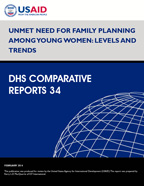- PUBLICATIONS
- JOURNAL ARTICLES
- ACCESS PUBLICATIONS
Publications Summary
- Document Type
- Comparative Reports
- Publication Topic(s)
- Family Planning, Fertility and Fertility Preferences, Youth
- Language
- English
- Recommended Citation
- MacQuarrie, Kerry L.D. 2014. Unmet Need for Family Planning Among Young Women: Levels and Trends. DHS Comparative Reports No. 34. Rockville, Maryland, USA: ICF International.
- Download Citation
- RIS format / Text format / Endnote format
- Publication Date
- February 2014
- Publication ID
- CR34
Download
 Unmet Need for Family Planning among Young Women: Levels and Trends (PDF, 1729K)
Unmet Need for Family Planning among Young Women: Levels and Trends (PDF, 1729K)
Supplement:
 Unmet Need for Modern Contraception among Young Women: Supplement to DHS Comparative Reports No. 34 (PDF, 470K)
Unmet Need for Modern Contraception among Young Women: Supplement to DHS Comparative Reports No. 34 (PDF, 470K)
Download this publication
Supplement:
